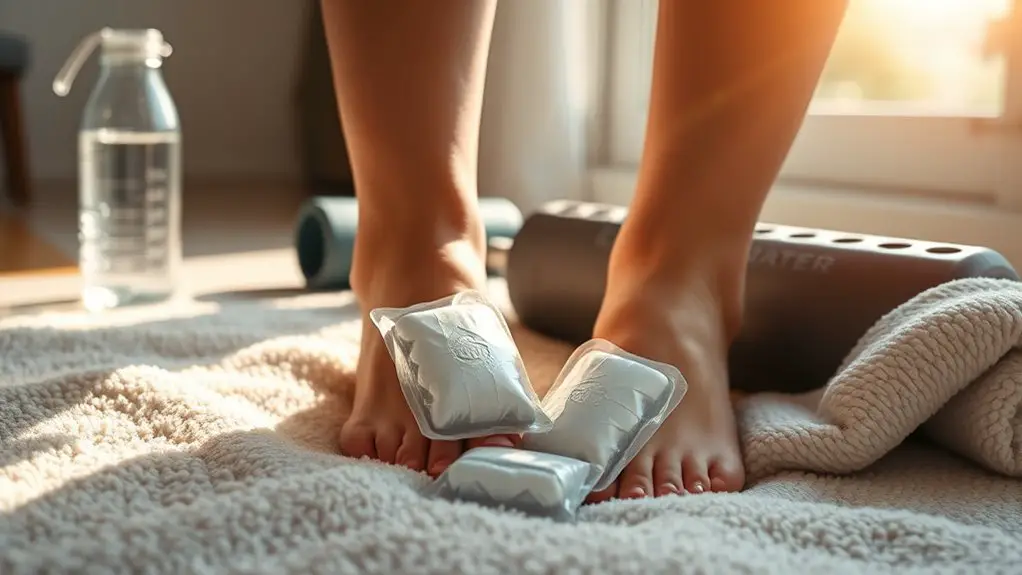To recover from shin splints quickly, you need to prioritize rest and avoid pushing through pain. Ice therapy can reduce inflammation, so apply ice for 15-20 minutes every few hours. Incorporate gentle stretching and strengthening exercises for your calves and shins. Invest in proper footwear that offers support and cushioning. Gradually return to activity with low-impact exercises, and maintain good nutrition and hydration. There's more you can do to guarantee a full recovery and prevent recurrence.
Understanding Shin Splints: Causes and Symptoms
Shin splints, or medial tibial stress syndrome, can be a real pain for anyone who loves to run or engage in high-impact activities. You might feel a sharp or dull ache along the inner part of your shin, especially during or after exercise. This discomfort can stem from several factors, including overuse, improper footwear, or running on hard surfaces. If you've recently ramped up your training intensity or changed your routine, that could be the culprit, too.
You may also notice swelling or tenderness in the affected area, making it hard to enjoy the freedom of movement you crave. Weakness in your lower leg muscles can contribute to this condition, as can flat feet or high arches. Understanding these causes and symptoms is crucial to reclaiming your active lifestyle and preventing future flare-ups. Strengthening exercises that focus on the lower legs can also play a vital role in recovery and prevention. So, let's dive deeper into how to address and overcome this pesky issue.
Rest and Recovery: The Importance of Taking a Break
When you're dealing with shin splints, taking a break is essential for your recovery. Your body needs time to heal, and pushing through the pain can lead to more serious injuries. Embrace this moment to let your muscles recover and regain strength. Remember, rest days are vital for recovery, rebuilding, and strength gain.
Here's a simple breakdown to help you understand the impact of rest:
| Day | Activity Level | Suggested Alternatives |
|---|---|---|
| 1 | No running | Light walking |
| 2 | Low impact | Swimming, cycling |
| 3 | Rest | Stretching routines |
| 4 | Light activity | Yoga or pilates |
| 5 | Gradual return | Short, easy runs |
Listening to your body is key. By respecting its need for rest, you'll not only recover faster but also enjoy the freedom to run again without pain. Prioritize your recovery, and soon you'll be back to your favorite activities.
Ice Therapy: Reducing Inflammation and Pain
Ice therapy is a powerful tool for reducing inflammation and pain from shin splints. By applying ice properly, you can enhance your recovery and find relief more quickly. Let's explore the benefits, application techniques, and how often you should use this method.
Benefits of Ice Therapy
To effectively manage shin splints, incorporating ice therapy into your recovery routine can be incredibly beneficial. Ice therapy helps reduce inflammation, which is key to alleviating pain and discomfort. By applying ice to your shins, you'll constrict blood vessels, limiting swelling and numbing the area, providing you with some immediate relief. This can make a significant difference in your ability to move freely and engage in activities you love. Regularly using ice can also speed up your recovery time, allowing you to get back to your routine sooner. Plus, it's a simple and cost-effective method that can be done at home. Embrace the power of ice therapy, and you'll feel the benefits as you reclaim your freedom to move.
Best Application Techniques
While applying ice therapy can seem straightforward, using the right techniques can enhance its effectiveness in reducing inflammation and pain from shin splints. To make the most of your ice therapy, consider these three tips:
- Wrap the Ice: Always wrap the ice pack in a cloth or towel to protect your skin from frostbite.
- Target the Area: Focus the ice on the affected shin area, ensuring you get the maximum benefit right where it hurts most.
- Elevate Your Leg: Elevating your leg while icing can help further reduce swelling and improve circulation.
Frequency and Duration
When recovering from shin splints, knowing how often and how long to apply ice can greatly impact your healing process. It's generally recommended to ice your shins for 15 to 20 minutes every 2 to 3 hours, especially during the first 48 hours after you start feeling pain. This frequency helps reduce inflammation and numbs the discomfort, allowing you to regain your freedom to move. Be sure to wrap the ice in a cloth to avoid skin damage. Listening to your body is key; if you notice increased pain or swelling, adjust your routine. Embrace this healing period, and soon enough, you'll be back to the activities you love without the nagging reminder of shin splints.
Stretching and Strengthening Exercises
To recover from shin splints, incorporating stretching and strengthening exercises is essential. You'll want to focus on effective stretching techniques to loosen tight muscles and strengthen key muscle groups that support your shins. This balanced approach can help prevent future injuries and improve your overall performance.
Effective Stretching Techniques
Incorporating effective stretching techniques into your recovery routine can make a significant difference in alleviating shin splints. By focusing on your muscles, you'll enhance flexibility and reduce tension. Here are three key stretches to include:
- Calf Stretch: Stand facing a wall, place your hands on it, and step one foot back, keeping it straight. Bend the front knee to feel the stretch in the calf of the back leg.
- Hamstring Stretch: Sit on the ground with one leg extended and the other bent. Reach for your toes on the extended leg, holding for 15-30 seconds.
- Anterior Tibialis Stretch: Kneel on the ground, sit back on your heels, and gently push down on your feet to stretch the front of your shins.
Incorporate these stretches daily to promote healing!
Strengthening Key Muscle Groups
While stretching is essential for recovery, strengthening key muscle groups is equally important to prevent future shin splints. Focus on your calves, tibialis anterior, and the muscles around your hips. Simple exercises like calf raises, toe taps, and clamshells can work wonders. Try doing three sets of 10 to 15 repetitions for each exercise, gradually increasing as you feel stronger. Incorporating resistance bands can also add intensity. Remember, balance is vital; don't neglect your core, as it supports your entire body during movement. By building strength, you'll enhance stability and reduce strain on your shins. Embrace these exercises, and you'll not only recover quicker but also enjoy the freedom to move without pain!
Proper Footwear: Choosing the Right Shoes
Choosing the right shoes can make all the difference in preventing and recovering from shin splints. When you lace up your kicks, contemplate how they support your journey toward freedom. The right footwear not only cushions your feet but also stabilizes your body, allowing you to move with ease.
Here are three key factors to reflect on:
- Arch Support: Look for shoes that match your foot's arch type—flat, neutral, or high. This helps maintain proper alignment.
- Cushioning: Choose shoes with adequate padding to absorb impact, especially if you're hitting hard surfaces.
- Fit: Verify your shoes fit snugly but not too tight. A good fit prevents unnecessary movement that can lead to injuries.
Investing in the right shoes can empower your recovery, letting you embrace the freedom of movement without pain. Proper footwear is crucial in preventing injuries and so, step into the right pair and take charge of your path to wellness!
Gradual Return to Activity: A Safe Approach
As you begin to recover from shin splints, it's crucial to approach your return to activity with caution. Rushing back into your routine can lead to setbacks, so take it slow. Start with low-impact exercises that won't strain your shins. Gradually increase the intensity and duration of your workouts as you feel more comfortable. Listen to your body; if you experience pain, it's a sign to scale back.
Incorporate rest days to allow your muscles to heal. You might feel enthusiastic to plunge into your favorite activities, but patience is key. Consider keeping a log of your progress, noting any discomfort or fatigue, which can help you adjust your plan accordingly. Engaging in active recovery techniques can also enhance your overall recovery process.
Cross-Training Alternatives to Maintain Fitness
To keep up your fitness levels during recovery from shin splints, consider incorporating cross-training activities that put less stress on your legs. This way, you can maintain your strength and endurance without risking further injury. Here are three effective alternatives:
Incorporate low-impact cross-training to maintain fitness and aid recovery from shin splints without risking further injury.
- Swimming: This full-body workout is easy on your joints and promotes cardiovascular fitness while allowing your legs to recover. Additionally, swimming offers enhanced cardiovascular endurance that supports overall fitness.
- Cycling: Whether on a stationary bike or outdoors, cycling strengthens your legs without the impact associated with running.
- Yoga: Focusing on flexibility and core strength, yoga can aid in your recovery and help prevent future injuries by improving your overall balance.
Embrace these activities to stay active and engaged during your healing process. Remember, maintaining your fitness doesn't have to mean pushing through pain; instead, you can enjoy the freedom of exploring new ways to move!
Nutrition and Hydration: Supporting Recovery
While you're focused on recovering from shin splints, nutrition and hydration play an important role in your healing process. Fuel your body with a balanced diet rich in lean proteins, whole grains, fruits, and vegetables. These foods provide the vitamins and minerals your body needs to repair tissues and reduce inflammation. Don't forget about calcium and vitamin D, essential for bone health.
Hydration is equally important. Drinking enough water helps maintain joint lubrication and supports cellular functions. If you're sweating during cross-training or physical therapy, consider electrolyte-rich drinks to replenish what you've lost. Proper hydration is essential for optimal performance and aids in recovery.
Listen to your body—it's your best guide. When you nourish yourself well and stay hydrated, you're not just speeding up recovery; you're setting the stage for a stronger, more resilient you. Embrace this time to heal and fuel your passion for movement, letting your body thrive in its natural rhythm.
Long-Term Prevention Strategies to Avoid Recurrence
In order to prevent shin splints from returning, it's vital to adopt a proactive approach to your training and recovery. You don't have to be held back; instead, take charge of your fitness journey with these strategies:
- Choose the Right Footwear: Invest in quality running shoes that provide adequate support and cushioning. Replace them regularly to guarantee they're not worn out.
- Gradual Progression: Increase your workout intensity and mileage gradually. Follow the 10% rule—don't increase your weekly distance by more than 10% to avoid overloading your shins.
- Incorporate Strength Training: Strengthening your calves, ankles, and core can help stabilize your legs and reduce the risk of injuries. Include exercises like calf raises and balance work in your routine. Additionally, performing dynamic stretches before your workouts can prepare your muscles and tendons, further aiding in injury prevention.
Frequently Asked Questions
Can Shin Splints Lead to Other Injuries if Untreated?
Yes, shin splints can definitely lead to other injuries if you don't treat them. Ignoring the pain might cause you to change your gait, putting extra stress on your knees and hips. It's best to address them.
How Long Does It Typically Take to Recover From Shin Splints?
Recovery from shin splints can feel like waiting for a storm to pass; typically, it takes a few weeks with proper rest and care. You'll reclaim your freedom to move and run pain-free again.
Are There Specific Sports More Likely to Cause Shin Splints?
Certain sports like running, basketball, and soccer are more likely to cause shin splints due to their high-impact nature. If you're involved in these activities, it's essential to pay attention to your body's signals.
Should I See a Doctor for Shin Splints or Treat Them at Home?
Did you know about 10% of runners experience shin splints? If you're feeling persistent pain, it's wise to see a doctor. However, for mild cases, home treatment can often provide relief and let you maintain freedom.
Can I Continue to Run if I Feel Mild Pain in My Shins?
If you feel mild pain in your shins, it's best not to push through it. Ignoring discomfort can lead to more serious injuries. Listen to your body, and consider alternative activities to give yourself a break.




